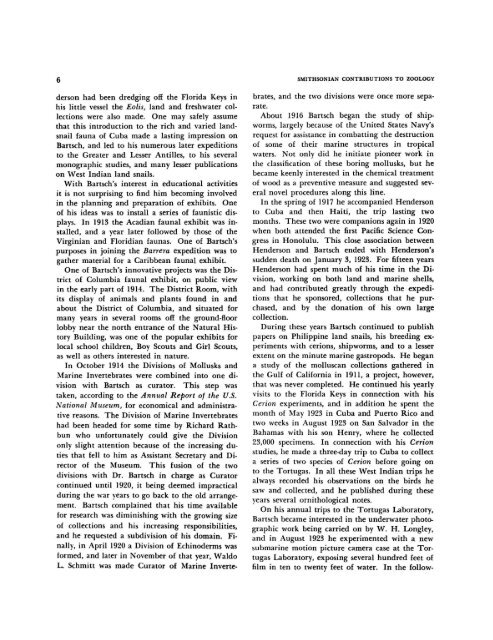Bibliography and Zoological Taxa of Paul Bartsch - Smithsonian ...
Bibliography and Zoological Taxa of Paul Bartsch - Smithsonian ...
Bibliography and Zoological Taxa of Paul Bartsch - Smithsonian ...
Create successful ePaper yourself
Turn your PDF publications into a flip-book with our unique Google optimized e-Paper software.
derson had been dredging <strong>of</strong>f the Florida Keys in<br />
his little vessel the Eolis, l<strong>and</strong> <strong>and</strong> freshwater collections<br />
were also made. One may safely assume<br />
that this introduction to the rich <strong>and</strong> varied l<strong>and</strong>snail<br />
fauna <strong>of</strong> Cuba made a lasting impression on<br />
<strong>Bartsch</strong>, <strong>and</strong> led to his numerous later expeditions<br />
to the Greater <strong>and</strong> Lesser Antilles, to his several<br />
monographic studies, <strong>and</strong> many lesser publications<br />
on West Indian l<strong>and</strong> snails.<br />
With <strong>Bartsch</strong>'s interest in educational activities<br />
it is not surprising to find him becoming involved<br />
in the planning <strong>and</strong> preparation <strong>of</strong> exhibits. One<br />
<strong>of</strong> his ideas was to install a series <strong>of</strong> faunistic displays.<br />
In 1913 the Acadian faunal exhibit was installed,<br />
<strong>and</strong> a year later followed by those <strong>of</strong> the<br />
Virginian <strong>and</strong> Floridian faunas. One <strong>of</strong> <strong>Bartsch</strong>'s<br />
purposes in joining the Barrera expedition was to<br />
gather material for a Caribbean faunal exhibit.<br />
One <strong>of</strong> <strong>Bartsch</strong>'s innovative projects was the District<br />
<strong>of</strong> Columbia faunal exhibit, on public view<br />
in the early part <strong>of</strong> 1914. The District Room, with<br />
its display <strong>of</strong> animals <strong>and</strong> plants found in <strong>and</strong><br />
about the District <strong>of</strong> Columbia, <strong>and</strong> situated for<br />
many years in several rooms <strong>of</strong>f the ground-floor<br />
lobby near the north entrance <strong>of</strong> the Natural History<br />
Building, was one <strong>of</strong> the popular exhibits for<br />
local school children, Boy Scouts <strong>and</strong> Girl Scouts,<br />
as well as others interested in nature.<br />
In October 1914 the Divisions <strong>of</strong> Mollusks <strong>and</strong><br />
Marine Invertebrates were combined into one division<br />
with <strong>Bartsch</strong> as curator. This step was<br />
taken, according to the Annual Report <strong>of</strong> the U.S.<br />
National Museum, for economical <strong>and</strong> administrative<br />
reasons. The Division <strong>of</strong> Marine Invertebrates<br />
had been headed for some time by Richard Rathbun<br />
who unfortunately could give the Division<br />
only slight attention because <strong>of</strong> the increasing duties<br />
that fell to him as Assistant Secretary <strong>and</strong> Director<br />
<strong>of</strong> the Museum. This fusion <strong>of</strong> the two<br />
divisions with Dr. <strong>Bartsch</strong> in charge as Curator<br />
continued until 1920, it being deemed impractical<br />
during the war years to go back to the old arrangement.<br />
<strong>Bartsch</strong> complained that his time available<br />
for research was diminishing with the growing size<br />
<strong>of</strong> collections <strong>and</strong> his increasing responsibilities,<br />
<strong>and</strong> he requested a subdivision <strong>of</strong> his domain. Finally,<br />
in April 1920 a Division <strong>of</strong> Echinoderms was<br />
formed, <strong>and</strong> later in November <strong>of</strong> that year, Waldo<br />
L. Schmitt was made Curator <strong>of</strong> Marine Inverte-<br />
SMITHSONIAN CONTRIBUTIONS TO ZOOLOGY<br />
brates, <strong>and</strong> the two divisions were once more separate.<br />
About 1916 <strong>Bartsch</strong> began the study <strong>of</strong> shipworms,<br />
largely because <strong>of</strong> the United States Navy's<br />
request for assistance in combatting the destruction<br />
<strong>of</strong> some <strong>of</strong> their marine structures in tropical<br />
waters. Not only did he initiate pioneer work in<br />
the classification <strong>of</strong> these boring mollusks, but he<br />
became keenly interested in the chemical treatment<br />
<strong>of</strong> wood as a preventive measure <strong>and</strong> suggested several<br />
novel procedures along this line.<br />
In the spring <strong>of</strong> 1917 he accompanied Henderson<br />
to Cuba <strong>and</strong> then Haiti, the trip lasting two<br />
months. These two were companions again in 1920<br />
when both attended the first Pacific Science Congress<br />
in Honolulu. This close association between<br />
Henderson <strong>and</strong> <strong>Bartsch</strong> ended with Henderson's<br />
sudden death on January 3, 1923. For fifteen years<br />
Henderson had spent much <strong>of</strong> his time in the Division,<br />
working on both l<strong>and</strong> <strong>and</strong> marine shells,<br />
<strong>and</strong> had contributed greatly through the expeditions<br />
that he sponsored, collections that he purchased,<br />
<strong>and</strong> by the donation <strong>of</strong> his own large<br />
collection.<br />
During these years <strong>Bartsch</strong> continued to publish<br />
papers on Philippine l<strong>and</strong> snails, his breeding experiments<br />
with cerions, shipworms, <strong>and</strong> to a lesser<br />
extent on the minute marine gastropods. He began<br />
a study <strong>of</strong> the molluscan collections gathered in<br />
the Gulf <strong>of</strong> California in 1911, a project, however,<br />
that was never completed. He continued his yearly<br />
visits to the Florida Keys in connection with his<br />
Cerion experiments, <strong>and</strong> in addition he spent the<br />
month <strong>of</strong> May 1923 in Cuba <strong>and</strong> Puerto Rico <strong>and</strong><br />
two weeks in August 1923 on San Salvador in the<br />
Bahamas with his son Henry, where he collected<br />
23,000 specimens. In connection with his Cerion<br />
studies, he made a three-day trip to Cuba to collect<br />
a series <strong>of</strong> two species <strong>of</strong> Cerion before going on<br />
to the Tortugas. In all these West Indian trips he<br />
always recorded his observations on the birds he<br />
saw <strong>and</strong> collected, <strong>and</strong> he published during these<br />
years several ornithological notes.<br />
On his annual trips to the Tortugas Laboratory,<br />
<strong>Bartsch</strong> became interested in the underwater photographic<br />
work being carried on by W. H. Longley,<br />
<strong>and</strong> in August 1923 he experimented with a new<br />
submarine motion picture camera case at the Tortugas<br />
Laboratory, exposing several hundred feet <strong>of</strong><br />
film in ten to twenty feet <strong>of</strong> water. In the follow-

















